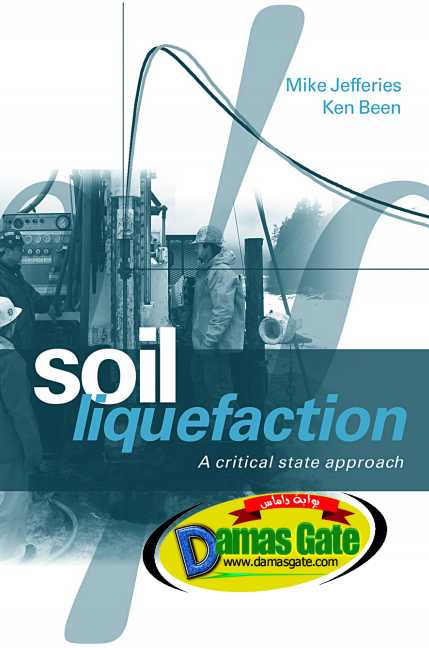Soil Liquefaction - Jefferies and Bean

Preface
Soil liquefaction is a phenomenon in which soil loses much of its strength or stiffness for a generally short time but nevertheless long enough for liquefaction to be the cause of many failures, with both deaths and some very large financial losses. Unsurprisingly, there is a vast literature on liquefaction. Apart from a sustained set of contributions to the usual journals over the past thirty years or so there have been publications by university departments specializing in the subject, specialty conferences, theme sessions at geomechanics conferences, state-of-the-art papers, two Rankine lectures, the Canadian Liquefaction Experiment (Canlex), a book by the National Research Council (USA) and research competitions sponsored by the National Science Foundation to test theories and modeling techniques (VELACS in particular).
So where does this book fit in? This book assumes some background in soil mechanics, and an interest in understanding liquefaction. But, this book is most certainly not an overview of the literature nor does it seek to strike a balanced view of the various theories and experience about liquefaction (if indeed a balanced view is possible). Rather the aim is demystifying liquefaction, both in terms of the physics of soil behaviour and how it can be avoided in practice by good engineering. To achieve these dual goals, a number of viewpoints are adopted:
- Full scale experience of liquefaction, while immensely important as calibration information, can be erroneously extrapolated without an underlying constitutive model to guide the interpretation of observations. An “understanding” of liquefaction is not enough, and a mere geological classification approach is unacceptable for engineering as such classification approaches are likely to mislead in some circumstances.
- Liquefaction is simply another facet of soil behaviour which proper constitutive models capture, including the effect of density and stress level on that behaviour. There are now several such models, and there is no need to resort to the witchcraft or dogma about liquefaction (e.g. “metastable soil particle arrangements” and similar “explanations” of the phenomenon).
- Constitutive models are idealizations, but idealization is not the sole domain of constitutive models. Both laboratory test data and physical model tests must be used equally cautiously. There are issues of scale.
- A proper appreciation of liquefaction thus requires a mixture of constitutive theory, soil properties and their determination (the in situ state in particular), and detailed evaluation of the case history record.
In exploring these views, the book does not follow the mainstream US and Japanese research on liquefaction. The reason is that the subject is much broader than earthquake engineering. There is also much valuable experience outside the Pacific Rim. More importantly, there are aspects of the Pacific Rim approach, which is based on a reference stress concept, that are questionable mechanics. In some instances, the usual reference
Soil liquefaction is a phenomenon in which soil loses much of its strength or stiffness for a generally short time but nevertheless long enough for liquefaction to be the cause of many failures, with both deaths and some very large financial losses. Unsurprisingly, there is a vast literature on liquefaction. Apart from a sustained set of contributions to the usual journals over the past thirty years or so there have been publications by university departments specializing in the subject, specialty conferences, theme sessions at geomechanics conferences, state-of-the-art papers, two Rankine lectures, the Canadian Liquefaction Experiment (Canlex), a book by the National Research Council (USA) and research competitions sponsored by the National Science Foundation to test theories and modeling techniques (VELACS in particular).
So where does this book fit in? This book assumes some background in soil mechanics, and an interest in understanding liquefaction. But, this book is most certainly not an overview of the literature nor does it seek to strike a balanced view of the various theories and experience about liquefaction (if indeed a balanced view is possible). Rather the aim is demystifying liquefaction, both in terms of the physics of soil behaviour and how it can be avoided in practice by good engineering. To achieve these dual goals, a number of viewpoints are adopted:
- Full scale experience of liquefaction, while immensely important as calibration information, can be erroneously extrapolated without an underlying constitutive model to guide the interpretation of observations. An “understanding” of liquefaction is not enough, and a mere geological classification approach is unacceptable for engineering as such classification approaches are likely to mislead in some circumstances.
- Liquefaction is simply another facet of soil behaviour which proper constitutive models capture, including the effect of density and stress level on that behaviour. There are now several such models, and there is no need to resort to the witchcraft or dogma about liquefaction (e.g. “metastable soil particle arrangements” and similar “explanations” of the phenomenon).
- Constitutive models are idealizations, but idealization is not the sole domain of constitutive models. Both laboratory test data and physical model tests must be used equally cautiously. There are issues of scale.
- A proper appreciation of liquefaction thus requires a mixture of constitutive theory, soil properties and their determination (the in situ state in particular), and detailed evaluation of the case history record.
In exploring these views, the book does not follow the mainstream US and Japanese research on liquefaction. The reason is that the subject is much broader than earthquake engineering. There is also much valuable experience outside the Pacific Rim. More importantly, there are aspects of the Pacific Rim approach, which is based on a reference stress concept, that are questionable mechanics. In some instances, the usual reference
Download
*